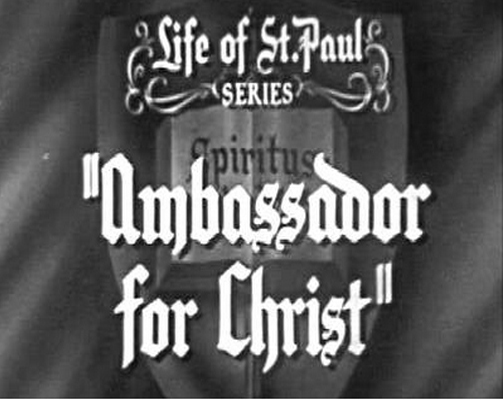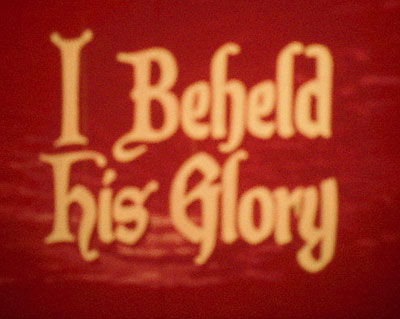Cathedral Films Feature Films

The Great Commandment
TIME Magazine Review from Nov. 6, 1939
The Great Commandment (Cathedral Films), as sombre as a pogrom and sometimes as bloodcurdling, tells the story of a Jewish revolt against the Romans in 30 A.D. After treating the audience to a pretty thorough study of oppression at its Roman worst, the picture knuckles down to entertaining. Joel (wistful, youthful John Beal) is leader of the Zealots, a Jewish revolutionary society. He has three problems: i) to defeat the Romans; 2) to win languid Tamar (Marjorie Cooley) who seems a little puzzled by all the excitement; 3) to convince his father, Rabbi Lamech (Maurice Moscovich), that it is better to free the Jews than to read the Talmud. The arrival of Jesus of Nazareth solves all these problems by teaching him a higher law than the sword.
Jesus is represented only by a deep, mellifluent voice, speaking parables in Biblical language. It is His disembodied Voice, trailing across the countryside, followed by His disciples, preaching the gospel and working miracles, that gives The ‘Great Commandment its nerve-tingling, eerie power. Good shot: the faces of unbelievers changing from scorn to incredulity as Jesus tells the story of the Good Samaritan (whom they regard as an Englishman does a Liverpool Irishman) who did not pass by on the other side.
In Red Wing, Minn., on the sweet grass prairie 60 miles from Minneapolis, there grew up the son of a wholesale grocer who was the victim of two apparently irreconcilable ambitions—to be a minister and to make moving pictures. His name was James Friedrich. For two years at the University of Minnesota young Friedrich was a 16 mm. movie bug, ran the Bell & Howell camera supply agency. Still resolved to be a minister, he transferred to the Protestant Episcopal Theological Seminary at Alexandria, Va. There pious, cinemad James Friedrich set a precedent by writing his doctor’s thesis (on the life of St. Paul) in the form of a movie script. He got his degree.
“It was a pretty amateur effort,” says he, but it fired him with the idea of combining his two passions. At Cincinnati’s Graduate School of Applied Religion he toyed with the idea of religious documentary films, dropped it and in 1937 went the whole way to Hollywood.
But it takes the things of this world to make even a religious picture. From his father, James Friedrich inherited about $200,000. In Hollywood he got himself a job as an assistant rector, rented two rooms at Selznick International Studios and hung out a sign reading: Cathedral Films. Author Dana Burnet supplied a script with plenty of entertainment value and with preaching carefully soft-pedaled. Once Friedrich met hard-bitten James Thompson Coyle, veteran Hollywood Jack-of-all-trades, and sold him on the idea that a religious picture could make money, Cathedral Films was ready to produce The Great Commandment in 17 days with a budget of $150,000. Last week, with Paramount, RKO and MGM, dickering for his picture, the Rev. Mr. Friedrich, movie producer and parson too, looked around for a typically U. S. town to test audience reaction to the film. He chose Joplin, Mo., birthplace of Cinema actor Beal.



Cathedral Films Features
The Great Commandment (1939)
81m. Cathedral Films’ landmark production is a feature-length fictional film about a Jewish zealot who shows mercy on a Roman soldier after hearing Jesus preach. The film was shot on the historic Selznick International
Studios in Culver City at the same time as Gone with the Wind was filming. Starring John Beal, Albert Dekker.
110m., color. The story of Christ unfolds in flashback as seen through the eyes of the apostle Andrew and the leader of the Zealot underground movement in Judea. The film was produced with a reverence for its sacred subject and scriptural source material. It has long been out of circulation.
I Beheld His Glory (1953)
This 53-minute television program, filmed in color, was presented during Easter 1953. Cornelius, a Roman Centurion (veteran actor George Mccready) who is open-minded about the teachings of Christ, becomes concerned for His safety after hearing about the plot to have Jesus killed. Cornelius finally converts to Christianity after hearing the story of Christ's Resurrection from the apostle Thomas.

Queen Esther: A Story from the Bible (1947)
55m. This is the Old Testament story of Persian King Xerxes, who chooses the beautiful Esther for his queen, unaware that she is Jewish. At the risk of her life, she appears before him to ask mercy for her people. This powerful film about
prejudice has never been transferred to VHS or DVD and unseen for more than 50 years.
Magnificent Adventure (1953)
84m.
Salt of the Earth (1947)
50m.
Two Kingdoms (1950)
62m. Story set in postwar Germany, where the thunder of bombs has been followed by the clash of ideas with the Christian ideal in the center of the struggle.
The Difference (1950)
45m.
Like a Mighty Army (1949)
53m.
For Good or Evil (1951)
45m.
Indian American (1955)
40m. Hugh Beaumont is a missionary on an Indian Reservation who encounters a slick real estate swindler that has been buying up land from the Indians at cheap prices.
Is This For Me? (1962)
44m. Produced by Family Films for Lutheran Church in America. Produced by the Rev. James Friedrich. Directed by Jan Sadlo. Examines whether a young college man
should train to become a minister.










